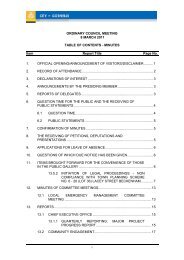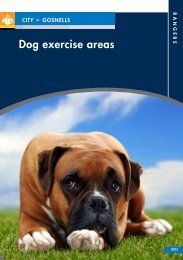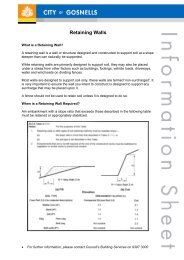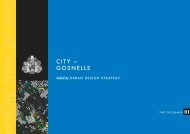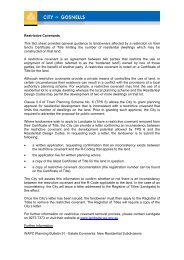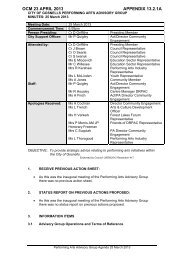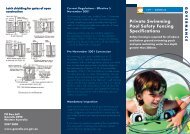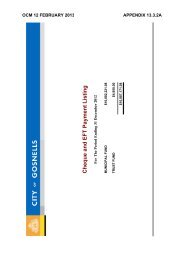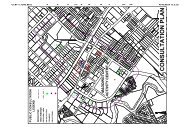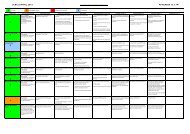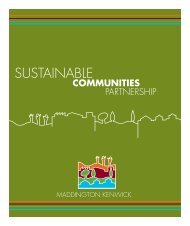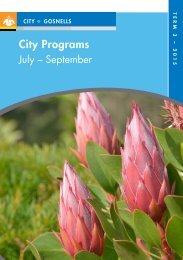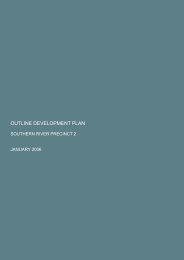Summary - City of Gosnells
Summary - City of Gosnells
Summary - City of Gosnells
You also want an ePaper? Increase the reach of your titles
YUMPU automatically turns print PDFs into web optimized ePapers that Google loves.
Regional Setting 156. Ephemeral Wetlands, a complex mosaic <strong>of</strong> shrublands, heaths, sedgelands and herblandsThe Corymbia calophylla and the Casuarina obesa woodlands and open forests and the wetland vegetationmosaic were considered to be the most common units prior to the large-scale clearing <strong>of</strong> the Pinjarra Plain.2.6.1.4 Floristic Community Types (FCTs)Early work to classify the vegetation <strong>of</strong> the Swan Coastal Plain using numerical classification <strong>of</strong> floristicdata was carried out by Havel (1968) and, later, by Heddle et al. (1980). More comprehensive survey andanalysis <strong>of</strong> the vegetation <strong>of</strong> the SCP was carried out by Gibson et al. (1994) to define finer-scale vegetationunits than those <strong>of</strong> the regional-scale Vegetation Systems <strong>of</strong> Beard (1979) and the Vegetation Complexes <strong>of</strong>Heddle et al. (1980). The vegetation units derived by Gibson et al. (1994; Government <strong>of</strong> Western Australia2000) are known as the Floristic Community Types <strong>of</strong> the Swan Coastal Plain (SCP FCTs).As there were only 43 FCTs identified for the entire SCP by Gibson et al. (1994), it is a fair assumption toconsider that these FCTs represent relatively high order units (as discussed by Trudgen, 1999, and by Griffin,Appendix C). In the current survey, the FCTs are therefore considered as sub-regional scale vegetation unitsto differentiate them from the local scale vegetation units that were mapped in the current study (and in otherstudies <strong>of</strong> the Greater Brixton Street Wetlands, including Mattiske and Associates, 1992) at a scale <strong>of</strong>approximately 1:5,000 or finer.The derivation <strong>of</strong> Floristic Community Types, after Gibson et al. (1994), is an example <strong>of</strong> a purely-floristicmethod <strong>of</strong> vegetation classification. In floristic classification, vegetation classes are defined by the grouping<strong>of</strong> standard-sized, sample plots <strong>of</strong> native vegetation (on the basis <strong>of</strong> the similarity matrices <strong>of</strong> the floristiccomposition <strong>of</strong> these plots) with the aid <strong>of</strong> s<strong>of</strong>tware such as PATN®. In the case <strong>of</strong> the FCTs <strong>of</strong> the SwanCoastal Plain defined by Gibson et al. (1994) and in subsequent update studies, the standard size <strong>of</strong> thevegetation sample plot from which floristic data are recorded for the purposes <strong>of</strong> FCT definition is a 10 m by10 m quadrat. It is important to note that the definition <strong>of</strong> FCTs on the SCP by this method does not includevegetation structure data or individual taxa abundance data from the vegetation sample plots in the analysis.Only presence/absence data <strong>of</strong> all vascular flora taxa (regardless <strong>of</strong> height and cover class) are included inthe analysis.In Gibson et al. (1994), 509 standard quadrats were surveyed on public lands throughout the SCP to recordfloristic data. A numerical classification <strong>of</strong> these vegetation samples resulted in the identification <strong>of</strong> foursupergroups <strong>of</strong> sites. These supergroups were correlated with three <strong>of</strong> the major geomorphic units <strong>of</strong> the SCP(Foothills/Pinjarra Plain, Bassendean Dunes and Spearwood/Quindalup Dunes) and seasonal wetlands. TheGibson et al. 1994 supergroups can thus be considered as showing regional scale patterning <strong>of</strong> the vegetationat approximately the same scale as the Vegetation Complexes <strong>of</strong> Heddle et al. (1980).Within the four supergroups <strong>of</strong> Gibson et al. (1994) there were a total <strong>of</strong> 43 clusters <strong>of</strong> sites. Each <strong>of</strong> these 43clusters <strong>of</strong> sites was designated by Gibson et al. (1994) as a Floristic Community Type (FCT). The SeasonalWetlands supergroup contained the largest number <strong>of</strong> FCTs. However, the mean number <strong>of</strong> quadrats thatwere sampled per FCT in this supergroup was the lowest <strong>of</strong> all the supergroups, i.e. the seasonal wetlandswere relatively poorly sampled in this study.Numerous attempts have been made (e.g. Trudgen, 1999) to numerically compare the floristics <strong>of</strong> thevegetation units derived by fine scale mapping on the SCP with the data obtained in Gibson et al. 1994. Thevegetation units recorded in environmental assessment projects, such as the current survey, that, on analysis,show affinity with the Gibson et al. (1994) FCTs that are recognised as Threatened Ecological Communities(DEC, 2007 and DEWHA, 2008) have very high conservation value. However, because most <strong>of</strong> theThreatened Ecological Communities (TECs) <strong>of</strong> the SCP are defined exclusively by their statistical similaritywith the FCTs found by Gibson et al. (1994), vegetation that does not show floristic affinity to these FCTs, is<strong>of</strong>ten, in practice, automatically deemed to be <strong>of</strong> low conservation significance. The results <strong>of</strong> such analyseshave <strong>of</strong>ten failed to recognise vegetation that is known to be genuinely rare and threatened on the SCP by themost experienced botanists and environmental scientists working in Western Australia (Trudgen, 1999 beingthe best documented example <strong>of</strong> this).The floristic classification <strong>of</strong> the vegetation <strong>of</strong> the SCP <strong>of</strong> Gibson et al. (1994) was later updated by theaddition <strong>of</strong> floristic data from a further 613 quadrats surveyed on both private and public lands <strong>of</strong> the SCPTauss, C. and Weston, A.S. (2010). The flora, vegetation and wetlands <strong>of</strong> the Maddington-Kenwick Strategic Employment Area.A survey <strong>of</strong> the rural lands in the vicinity <strong>of</strong> the Greater Brixton Street Wetlands. Report to the <strong>City</strong> <strong>of</strong> <strong>Gosnells</strong>, W.A. Version 18.04.10



